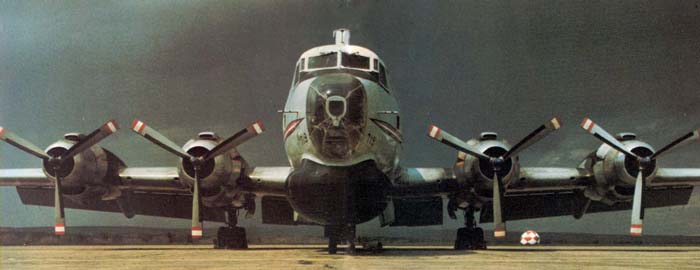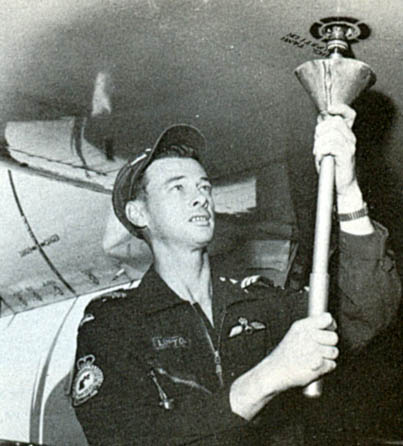 |
| This Argus is awaiting its next mission (Canadian Forces photo # HC 80 112 from Sentinel 1981/03) |
 |
| This Argus is awaiting its next mission (Canadian Forces photo # HC 80 112 from Sentinel 1981/03) |
 |
| Sgt. Bill Lupton of 405 Squadron is "dripping" the tanks - a process which ensures that the fuel tanks are all topped up. (Canadian Forces photo from Sentinel Magazine Nov-Dec 1969) |
Groundcrew from 404 (Buffalo) Squadron , Greenwood Nova Scotia worked around the clock to keep aircraft and equipment in flying trim during NATO Exercise Silver Tower in 1968. The jet start unit is seen in the lower left of the photo. During the exercise four crews flying three aircraft logged about 300 hours or an average of 17 hours per flight, a tremendous effort by all. (Canadian Forces photo from Sentinel Magazine, January 1969)
MCpl Jim McLean an air frame technician, checks this Argus nosegear. (Canadian Forces photo IHC 81-74 from Sentinel Magazine 1981/3)
It was not unusual for the second Flight Engineer open the upper escape hatch ( properly called the pilot compartment overhead escape hatch) and use it as a lookout position when taxing, especially when the aircraft was deployed to unfamiliar locations or air bases. It was especially so in the UK where the taxiways were narrow and the marker lights were quite tall. (the Brits let the grass grow at their bases to keep the birds away). As an example, at Kinloss, the pilots would shut down the outer engines and the FE would incrementally turn them with the starter motor so that the blades were in an upside-down "Y" configuration in order to pass over the lights without hitting them. There was also a second hatch, in the floor of the passageway to the nose and just where you step down from the main floor, that was to be used for parachute bailout. (Canadian Forces photo from Sentinel Magazine Nov-Dec 1969)
During exercises a tug towed a target and the two smoke markers indicated where the first and last bombs landed. (Canadian Forces photo from Sentinel Magazine Nov-Dec 1969)
The target is designed to throw up a curtain of spray which simulates the same as created by a sub's periscope or snort mast as it passes through the water. The surface area of this curtain is significantly larger than the masts, which are round and deflect a lot of radar energy. It's the curtain that is the primary reflector in most instances. This attack run would certainly have gotten good marks but it isn't perfect. Here the "stick" was dropped lightly late. Ideally, the smoke markers would have been biased to the other side of the target so that after the underwater travel vector, they would have bracketed the boat. In a "perfect" drop the stick would have been at a 45 degree angle to the target MLA (mean line of advance) to increase the probability that more than one depth charge had a killing impact. The killing radius of the MK 54 depth charge was only about 16 or 20 feet and that was against a WW II type submarine with far thinner steel plate than that used in the post-war subs. Nevertheless they would have done a great deal of damage and at the end of the day the boat would have been out of action which was the real objective. Eventually MK-54's were withdrawn from service in the late 70's.All those bombs wound up at the Bedford magazine and for a couple of years Sea King crews would take one out to the training area south of Shearwater and let it go. It was a far different experience dropping one from a chopper when compared to the Argus where is was dropped from 300 ft at 180 knots per hour. The Sea King release parameters were 90 knots and 150 feet. The shock wave would give the helicopter quite a thump in the back end causing the tail to kick up a bit. Needless to say the pilot's heart skipped a beat the first time one was dropped.
Credits and References:
1) Ian Snow <va3qt-4(at)sympatico.ca>
Back to Argus Main Document Apr 13/09